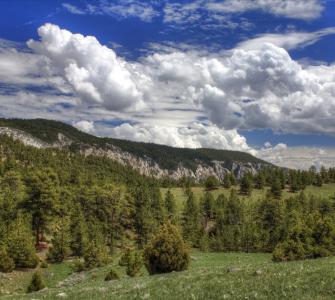Background
Wyoming’s forests are essential ecosystems that regulate and supply water, provide habitat for valued species, sequester carbon, and provide timber among many other important goods and services to the people of Wyoming. As forest managers across Wyoming work towards the shared goal of accelerating the pace and scale of forest restoration, there is a collective need to better understand and leverage the economic value of these ecosystems’ natural capital. As most resource management decisions are made by comparing benefits and costs, translating these tangible and intangible ecosystem benefits into monetary values can help facilitate better decisions. In this context, The Nature Conservancy in Wyoming (TNC) engaged Conservation Strategy Fund (CSF) to conduct a valuation study of the ecosystem services provided by forests in the state.
Our Method
For this analysis, we are used a combination of primary and secondary data, GIS analysis, and expert consultation, including Equilibrium Economics for their experience in forest in the region. A special focus was given to water-related services, outdoor recreation, and habitat services.
The results and recommendations of this analysis will be useful to diverse stakeholders, including forest managers and natural resource decision makers, including the Federal Emergency Management Agency (FEMA) for pre and post-fire mitigation cost-benefit analysis required for FEMA risk mitigation grants. The results will also be extremely beneficial in making the case for new funding streams in support of TNC’s long-term conservation and forest restoration in Wyoming.
Key Findings
- As a system, Wyoming’s 9.2 million acres of forests provide between $22.3 billion to $28.8 billion of benefits every year. These values represent both market revenues and non-market benefits provided to both Wyoming residents and businesses as well as benefits provided beyond state lines.
- If their benefits are protected and harnessed, the asset value of Wyoming forests, over the next 100 years, is between $983 billion and $1.3 trillion.
- The ecosystem service valuation analysts that conducted this study believe these overall values to be conservative and under-estimates.
- The beneficiaries of Wyoming’s forest ecosystems are many and diverse, and a coordinated effort is needed to protect and grow this vast wealth encapsulated in Wyoming’s rich natural lands.
- Conserving healthy forests as a critical asset should be a clear priority for stakeholders and forest land managers in Wyoming.
- A warmer, drier climate and decades of under-funded forest management have made forests susceptible to increased wildfire and vulnerable to disease and insect damage.
- Increased and more targeted investments in forest restoration and conservation give us our best chance to reduce the worst risks of climate change, and create healthier air, lands, and waters.
- Reducing risk and restoring resilience will require a whole-of-society approach with input and efforts from all levels of government, the private sector, communities, and other stakeholders.
Learn More
- Our results are now available in this publication, and on this webpage.
This project was supported by The Nature Conservancy - Wyoming.
Photo Credit: The Bureau of Land Management Wyoming, USA

